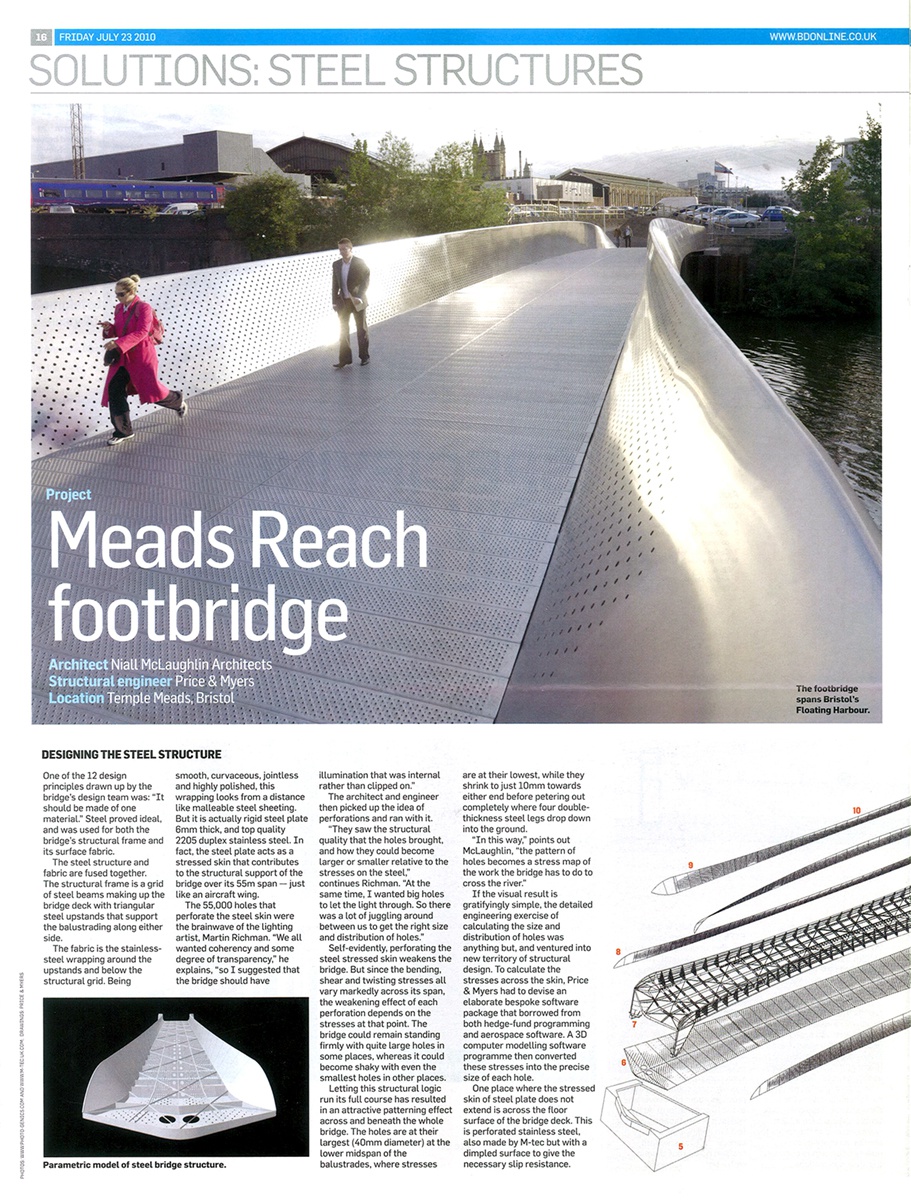Meads Reach Footbridge - Building Design
Issue 1927
July 2010
Text Martin Spring
Images Price and Myers
One of the 12 design principles drawn up by the bridge’s design team was: “It should be made of one material.” Steel proved ideal, and was used for both the bridge’s structural frame and its surface fabric. The steel structure and fabric are fused together. The structural frame is a grid of steel beams making up the bridge deck with triangular steel upstands that support the balustrading along either side.
The fabric is the stainless steel wrapping around the upstands and below the structural grid. Being smooth, curvaceous, jointless and highly polished, this wrapping looks from a distance like malleable steel sheeting. But it is actually rigid steel plate 6mm thick, and top quality 2205 duplex stainless steel. In fact, the steel plate acts as a stressed skin that contributes to the structural support of the bridge over its 55m span – just like an aircraft wing.
The 55,000 holes that perforate the steel skin were the brainwave of the lighting artist, Martin Richman. “We all wanted coherency and some degree of transparency,” he explains, “so I suggested that the bridge should have illumination that was internal rather than clipped on.”
The architect and engineer then picked up the idea of perforations and ran with it. “They saw the structural quality that the holes brought, and how they could become larger or smaller relative to the stresses on the steel,” continues Richman. “At the same time, I wanted big holes to Let the light through. So there was a lot of juggling around between us to get the right size and distribution of holes.”
Self-evidently, perforating the steel stressed skin weakens the bridge. But since the bending, shear and twisting stresses all vary markedly across its span, the weakening effect of each perforation depends on the stresses at that point. The bridge could remain standing firmly with quite large holes in some places, whereas it could become shaky with even the smallest holes in other places.
Letting this structural logic run its full course has resulted in an attractive patterning effect across and beneath the whole bridge. The holes are at their largest (40mm diameter) at the lower midspan of the balustrades, where stresses are at their lowest, while they shrink to just 10mm towards either end before petering out completely where four double thickness steel legs drop down into the ground. “In this way,” points out McLaughlin, “the pattern of holes become s a stress map of the work the bridge has to do to cross the river.”
If the visual result is gratifyingly simple, the detailed engineering exercise of calculating the size and distribution of holes was anything but, and ventured into new territory of structural design. To calculate the stresses across the skin, Price & Myers had to devise an elaborate bespoke software package that borrowed from both hedge-fund programming and aerospace software. A 3D computer modelling software programme then converted these stresses into the precise size of each hole. One place where the stressed skin of steel plate does not extend is across the floor surface of the bridge deck. This is perforated stainless steel, also made by M-tec but with a dimpled surface to give the necessary slip resistance.
The 55,000 perforations were laser cut through the steel plate by fabricator M-tec using CNC technology. The steel plates were preformed to their double-curved outline. The plates were then welded to the structural ribs and invisibly butt-welded end to end to form eight large sections up to 7m long. These were transported to site, where they were pre-assembled alongside the canal basin. Erection culminated in hoisting the entire 75-tonne structure into its final position, a process that was carried out in one day by Britain’s Largest mobile crane. “It was,” recalls Mclaughlin, “a spectacular national TV event.”
